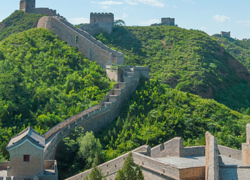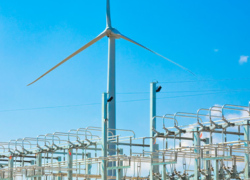China & Latin America in 2013
This post is also available in: Español
 Roberto Stuckert Filho / PR / CC BY-NC 2.0
Roberto Stuckert Filho / PR / CC BY-NC 2.0
2013 was the 15th year of China’s “going out” initiative – a strategy designed to systematically promote exports, gain access to needed resources, and accelerate the development of its multilateral enterprises. During this period, the Asian giant’s economic relations with Latin America expanded rapidly. Today China’s trade with Brazil, Chile, and Peru tops that of any other country. Some estimates suggest that in 15 years, China will become Latin America’s largest trade partner.
Economic ties have not only grown larger and more intense. They are also more varied, and more complex. After a decade of enhanced relations, the China-Latin American relationship has matured and policies and practices have become more sophisticated and nuanced. While there is still a lot to be learned by both China and Latin America, Chinese agencies and companies are today far more informed about the region, make use of a wider range of commercial instruments, and work productively throughout Latin America, adapting to the differentiated challenges of each country. For their part Latin American governments and corporation are increasingly effective in negotiating with their Chinese counterparts and dealing with the multiple institutions involved in foreign investment, lending, and trade. The core objectives of the relationship, however, have remained remarkably constant.
For Latin America, China is both an immense, fast growing market, particularly for the region’s oil, mineral resources, and agricultural produce and, increasingly, a critical source of loans and investment capital. For China, Latin America is a major supplier of the raw materials for the county’s still rapidly expanding industrial sector and a dependable source of food and energy. China and Latin America have become essential economic partners.
A Year of Change
In both China and Latin America, 2013 has been a year of considerable change. After serving two terms (ten years) as vice president, Xi Jinping took over as president in March of this year, shortly after being named chair of the Communist Party in 2012. One of his first visits abroad was to Latin America and the Caribbean, with stopovers in Trinidad and Tobago, Costa Rica, and Mexico—all just prior to meeting with US president Barack Obama in California. In November, the Xi administration announced its most ambitious redirection of China’s economic policy in recent years, giving new emphasis to domestic markets and consumer demand, and adjusting to slower growth (in the 7 to 8 percent range) after nearly three decades of ten percent annual economic expansion.
Chinese companies appear to have become more wary of investing in countries faltering economies like Venezuela and Argentina, and worries about Brazil’s economic prospects have increased. Yet China has remained engaged in virtually all of Latin America’s resource-rich nations to meet its needs for their energy, mineral, and agricultural resources.
This has also been a year of change for Latin America. The death of Venezuela’s bombastic anti-American leader, Hugo Chavez, represented a marked shift for that country and the region generally. His replacement, Nicolas Maduro, a far-less charismatic and skillful leader, confronts a rapidly deteriorating economy, which threatens the country’s stability and has sharply reduced Venezuela’s influence in hemisphere affairs. Mexico’s new president Pena Nieto, who took office in December 2012, has pursued an exceptionally far-reaching agenda of economic and political reform intended to bolster the country’s growth and competitiveness. Although the outcome is far from certain, the Colombian government has made progress toward negotiating an end to its cruel 50 year-old war with the FARC insurgents. Brazil—China’s most important partner in Latin America—is struggling to reenergize a stumbling economy while responding to the rising demands of an increasingly affluent population that is unhappy with political corruption and the low quality of public services. The growing anger and impatience of newly middle class citizens has emerged as central political challenge throughout much of Latin America.
None of these changes, however, has dramatically altered relations between Latin America and China, which continue to be driven largely by economic interests. Trade and investment are what matter most to both China and Latin America, and remain the essential foundations of the relationship.
There have been few reported complaints of Chinese political intrusion or pressure. China has not brought a political or ideological agenda to the region. It has retained cordial relations with Latin American countries that recognize Taiwan, and has not pressed them to shift their allegiance. Latin Americans welcome China largely as an important and pragmatic economic actor. They are not worried that China will take advantage of its growing influence to shape political outcomes, recruit partners for its global objectives, or to compete with the US for allies.
To be sure, Chinese companies appear to have become more wary of investing in countries faltering economies like Venezuela and Argentina, and worries about Brazil’s economic prospects have increased. Yet China has remained engaged in virtually all of Latin America’s resource-rich nations to meet its needs for their energy, mineral, and agricultural resources.
Venezuela and Argentina
China maintains its oil investments in Venezuela and continues to lend to the country in exchange for payments in oil, although some analysts suggested that President Maduro may have returned from his visit to Beijing this year without meeting his borrowing goals. Chinese companies are among a very small number of foreign firms that have committed themselves to invest in shale gas exploration and production in Argentina, and China continues to be major buyer of the nation’s soy crop.
Brazil
Brazil occupies a special place in China’s relationship with Latin America. Brazil is the most globally active and influential of the region’s nations. The two countries are fellow members of the BRICS group of leading developing nations and see each other as potential and valued allies on many issues. In 2012, Brazil and China upgraded their relationship to a comprehensive strategic partnership (from merely a strategic partnership). This designation probably exaggerates the extent of their cooperation, but they share a continuing and substantial interest in expanding their own influence and that of other developing countries in critical multilateral institutions, the UN, the G-20, World Bank and IMF, and WTO.
It is, however, bilateral economic ties that are the core of Brazil-China relations. Brazil is China’s largest economic partner in Latin America—although China exports more to Mexico than Brazil. This year, China and Brazil negotiated a currency swap of $30 billion to facilitate increased trade. This past October, Brazil held its first auction of rights to drill in its huge, recently discovered “pre-salt” oil fields. Some 40 oil companies were expected to participate, but Brazil’s new regulatory framework discouraged most of them and the auction drew only four foreign bidders, two of which were Chinese firms. Without China’s participation, this initial sale of drilling rights would have been viewed as failure.
But some rough spots have emerged in the China-Brazil relationship. Many in Brazil are concerned that Chinese industrial exports are cutting into Brazil’s market share worldwide and making inroads into its domestic markets. Brazil is troubled about the prospect of deindustrialization—that China’s manufactured export success may lead to a shrinking of Brazil’s industrial sector, leaving the country too heavily dependent on commodity exports and technologically backward. This concern is the main source of Brazil’s longstanding complaint about Chinas undervalued currency (which has lost much of its validity).
China is mainly worried about Brazil’s protectionist policies in certain sectors (which are sometimes perceived as anti-Chinese). A reinterpretation of Brazil’s land ownership laws in 2010 seemed directed to Chinese investors—as was a recent tax on motor vehicle imports. Chinese firms and investors often underscore the special problems in reaching agreement in Brazil as compared to other Latin American countries. They have experienced particular difficulties with regard to their investments in agriculture and infrastructure.
There is, nonetheless, enormous potential for the continued expansion of Chinese-Brazilian commercial ties in the coming period. Brazil’s energy sector, despite the restrictions it operates under, should present huge opportunities as Brazil’s immense pre-salt oil reserves are developed. Notwithstanding high import tariffs, Chinese autos are expected substantially to increase their share of the Brazilian market. Agribusiness in Brazil should represent a range of new opportunities.
Pacific Alliance and Other Nations
China has been active in several other Latin America countries, including those that now make up the Pacific Alliance (Chile, Colombia, Peru, and Mexico). Most of these countries have demonstrated a consistently solid economic performance in recent years and are actively working to attract trade and investment from China. Chile, the only South American country with a free trade agreement with China, is a major commercial partner, with two-way trade totaling about half of China’s trade with Brazil, which has a GDP some eight times that of Chile. China’s interest in Peru, with its huge mining sector, is certainly not surprising. China is now both Peru’s leading trade partner and its largest foreign investor. Ecuador and Bolivia are other South American nations with important and growing economic relations with China.
Although Mexico’s economic record in 2013 has fallen short of the other Alliance countries, it is in the midst of an impressive reform process that may allow Mexico to regain its position as a world class oil exporter and begin a period of faster growth. Mexico is already major market for China’s industrial production. It imports more than any other Latin American nation (about one third more than even Brazil)—and it is also gateway to the US market. However, the two countries also see themselves as rivals for exports to the US. Now that Chinese wages are rising and reaching Mexican levels in some areas, the competition is sharpening. China is clearly focusing more attention on Mexico, and both countries appear committed to bolstering their relations. Three new Mexican studies centers were established in China just this year.
Central America and the Caribbean
Central America and the Caribbean continue to be the focus of ongoing diplomatic competition between mainland China and Taiwan. Those countries that diplomatically recognize mainland China receive considerably more Chinese investment and aid than those affiliated with Taiwan. Xi’s trip to Trinidad and Tobago made clear continuing Chinese support for Caribbean nations, as well as an interest in Caribbean-based oil reserves. China’s biggest surprise in 2013 for Central Americans may have been the reports in midyear that a Chinese businessman had gained approval from the Nicaraguan government to begin exploration for the development on a second canal through the Central American Isthmus. There has been little news since then and questions remain about the seriousness of the initiative and the extent to which the Chinese government is involved.
Concerns about the Chinese Economy
Across Latin America, reduced rates of economic expansion are expected. However, most nations continue to count on steady demand from Beijing to sustain a period of solid, although slower, advance for Latin America—at least until there is a stronger recovery in the US and Europe.
In 2013, in much of Latin America, there was increasing unease about China’s slowing economy. Latin Americans are very much aware that the spurt of growth in the region after 2004 (particularly among commodity exporters) was in significant measure due to the rising demand from China’s economic expansion. It was China’s demand for commodities that led to the higher prices and huge volume of exports that drove Latin America’s growth to levels not experienced for more than a generation. The Chinese purchases also served to insulate the region from the US and European economic reversals in 2008. Across Latin America, reduced rates of economic expansion are expected. However, most nations continue to count on steady demand from Beijing to sustain a period of solid, although slower, advance for Latin America—at least until there is a stronger recovery in the US and Europe. Latin Americans are painfully aware of the potentially damaging consequences for their economies should China’s growth rate slip to less than seven percent.



















